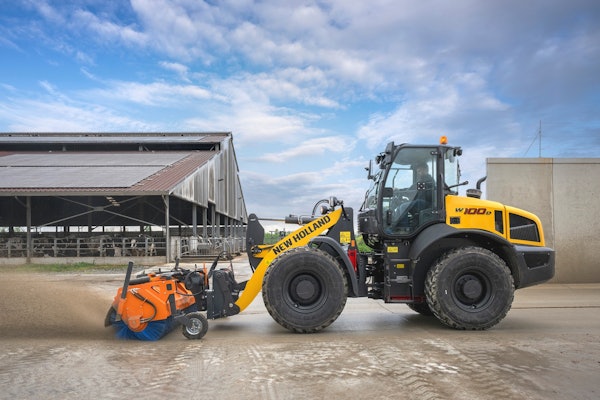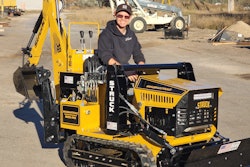When it comes to choosing greases for heavy equipment fleets and trucks a “one-grease-fits-all” approach isn’t always in your best interest. A multi-purpose grease may work fine in many situations. But when the weather, operating conditions or applications change you need to know some fundamental facts about grease to determine whether or not a different product is called for.
In doing so you can protect your equipment better and perhaps save money by specifying the right product for the job. You’ll also avoid grease-related downtime and you won’t have to deal with ticked off operators leaving the cab in the middle of a shift to call the service truck or grab a grease gun. The right product does make a difference here.
OIL VISCOSITY
The building blocks of any grease are oil, thickeners and additives. The base oils that make up a particular grease can have a wide range of viscosities. As with engine oils you can get synthetic or mineral oil. Synthetic greases can be more expensive, but better resist oxidation in extreme high temperature situations. They also provide better pump-ability or mobility especially in automatic lubrication dispensing systems in severe cold weather operations.
The base oil does the primary lubrication, says Corey Taylor, grease technology manager, BP Lubricants USA. The speed of the moving parts in the component being greased will dictate to some extent, the viscosity of the base oil. “If they’re too thin for a slow moving part that’s heavily loaded, it won’t protect the metal surfaces,” he says. “If you have a high-speed application, such as an electric motor, an oil that’s too thick will cause the bearings to overheat.”
ADDITIVES
To address specific needs some greases include additives. Molybdenum disulfide or “Moly” is widely used.
Greases containing 3 or 5 percent Moly are also typically EP greases that are used for extreme pressure applications. The fine molybdenum disulfide particles help to fill in microscopic machining marks found on the pin and bushing and help prevent the two surfaces from grinding against each other during heavy stress and shock loading, says John Geyer, commercial and industrial account manager for off-highway lubricants at Chevron.
Note that not all EP packages are Moly-based. Manufacturers have a variety of other additives and base oil selections that can give excellent performance properties. Some of these are proprietary, some not.
THICKENERS
Without thickeners, grease pumped into a joint or bearing would quickly run out again. The less thickener in the formula, the better a grease may pump in cold weather. The thicker you make a grease, the better it may adhere to metal surfaces in hot weather or high temperature applications. Keep in mind that base oils of a grease can also affect how well a grease may pump or adhere to equipment surfaces.
Today’s grease thickeners used in most heavy equipment greases are actually soaps. They act like a sponge, holding the base oils in suspension to lubricate the equipment without draining out as industrial oils would in non-sealed bearing applications. The most commonly used thickeners are lithium or lithium complex based, but there are also aluminum and calcium soaps as well. In addition to regular thickeners, there are “complexes.” Complex greases can hold the base oils in suspension within the thickener better, especially in high temperature situations.
- Lithium and lithium complex thickeners work well in a variety of applications and comprise the majority of the market. “Lithium is like the universal blood donor,” says Mark Betner, heavy duty lubricants manager, Citgo Petroleum. “If you switch brands, you’re less likely to have an compatibility problem with two lithium greases.”
- Aluminum and aluminum complex thickeners are often spec’ed for applications where there is substantial exposure to water, such as dredging operations or work done below the water table.
- Calcium sulfinate thickeners also do well against water except against water spray.
- Polyurea is a synthetic thickener with good oxidation stability that’s finding increasing popularity in high speed, electric motor bearings and sealed-for-life bearings.
Keep in mind some thickener types are incompatible, particularly lithium and aluminum. When these mix, the grease can soften and possibly run out of the application. Some combinations of greases can make the grease actually harden. If you do switch from one type of thickener to another, thoroughly purge all the old grease out of the application and refill the lube point per OEM recommendations with the new grease.
GREASE SPECS
The thickeners and the oil viscosity determine a grease’s National Lubricating Grease Institute grade. These run from NLGI grade 000, which approximates the thickness of heavy gear oil, to NLGI grade 6, which is a block of solid lubricant. Most heavy equipment and truck greases run from NLGI grades 00 through 2, with NLGI 2 being the most common of the NLGI grades.
Dropping point is another way to gauge a grease’s ability to handle heat. The dropping point is the temperature at which the oil separates or “drops” out of the thickener. A rule of thumb is that a safe operating temperature is 100 degrees below a grease’s dropping point. Regular lithium grease has a dropping point of 350 degrees, says Betner. A lithium complex formulation can raise the dropping point another 100 to 150 degrees. Synthetic base oils offer grease the additional ability to withstand higher sustained operating temperatures.
CHOOSING THE RIGHT GREASE
The first source you should turn to when choosing a grease is your owner’s manual or the specs provided by the manufacturer. But also discuss applications and options with your lube supplier. To simplify inventory and prevent greasing mistakes a lot of contractors prefer to spec a single type of grease. But a one-size-fits-all approach requires some trade offs.
For example, while some major equipment manufacturers insist on moly for pins and bushings, this additive isn’t a universal solution for all greasing needs. Molybdenum particles may interfere with other anti-wear additives, especially in anti-friction bearings, Betner says. The bottom line is that Moly greases best serve articulating pins and bushings in high-load applications, but should not be thought of as a universal upgrade in all situations, he says.
You also need to discuss the various permutations of base oil viscosity and thickener. High viscosity base oils along with extra thickener can decrease the product’s pump-ability, especially in colder weather. Remember, thickener helps to keep the grease in place. It is the oil viscosities that deliver a range of performance attributes. “One of the things that can confuse people about these unique lubricants is that a grease with a specific NLGI grade, let’s use NLGI 2 for example, could actually consist of thousands of base oil viscosities depending on the manufacturer you choose,” says Geyer. “So unless I know the application, the bearing speed or surface load, the external temperature, actual operating temperature, possible contaminants, weather extremes and other factors, I can’t make a good recommendation.”
You’ll also need to find out if the high temperatures will be sustained or intermittent. Disc brakes, for example, experience intermittent temperature spikes up to 450 degrees, but run much cooler otherwise. The shaft bearing in the auger of an asphalt paver, however, will deal with sustained temperatures of 300 degrees or more all day long. You probably need a much more muscular grease on that 300-degree paver auger than you would the intermittent 450-degree disk brake component. Both will require high temperature (complex) greases to meet the demands listed above.
HOT AND COLD
If nothing else, seasonal variations in temperature may prod you to reconsider a one-size fits all approach to grease. “Usually about this time of year, especially in the Northeast, you’ll have a guy switch from an NLGI #2 grease to a #1 grease,” says Taylor. “In very cold climates like Montana, you’d recommend a synthetic base-oil grease.”
“If they come to me and say, ‘I want this product to pump year round,’ I can recommend a grease with a lighter base oil viscosity that will pump year round, but explain they’ll likely have to give up some performance in the summer when it’s hot,” Geyer says. “They may also have to grease much more frequently. Lighter viscosity oils in the summer tend to give you pin squeak three to four hours or sooner into a shift. And squeak is a bad thing. Any operator will tell you it means metal-to-metal contact.”
GREASE FOR TRUCKS
According to Betner, equipment managers today are faced with three forces affecting re-lubrication of truck chassis.
- Longer service intervals. “We used to lube the chassis every 3,000 miles. Now we’re out maybe 30,000 in some cases, Betner says. “They just don’t get to see the truck that often. Many fleets don’t have that luxury. So what you really want in a grease for trucks is staying power as well as wear protection.”
- Magnesium and calcium chloride used as de-icing agents on many roadways today is very corrosive. Once it gets inside these chassis components it can do a lot of damage.
- Drivelines are a lot more powerful than they used to be a few years ago.
Betner recommends greases with high viscosity base oils to stand up to these challenges. “They do two things. They prevent water wash out and they stay in longer,” he says. “A good truck grease will have an ISO 320 or 460 base oil. The game is to find a grease that will stay in place.”
Grease points for trucks may include kingpins, U-joints, spring and shackle pins, slack adjusters, cam brake bushings and the steering linkage. But a lot of fleet managers will use a different grease on the fifth wheel. “Some guys think Moly won’t wash off on the fifth wheel, but a good grease with the right oil will work on the fifth wheel just as well without Moly,” Betner says.
Grease with tackifier additives can also be spec’ed on fifth wheel applications, says Taylor. Tackifiers are synthetic materials that help the grease adhere to a surface and resist the kind of spray and washout a fifth wheel encounters.








